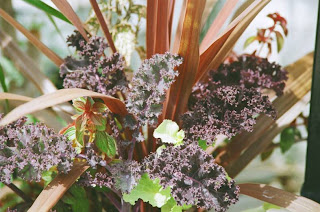“Let them eat cake” is the response infamously attributed to Marie Antoinette after being told that her loyal subjects could no longer afford bread. Perhaps if the lady Marie would have been trained in the gardening arts (or maybe if she just wasn’t so cruel) her answer would have been something more like “Let them grow gardens”.
Many city residents are concerned that their lawn space is too small or too shaded to grow edible plants. Some folks worry that edible plants may be less than lovely, and they don’t want to compromise their desire for a beautiful landscape. We urban folk can also sometimes forget that we have the power to care for some of our most basic needs in our own back yards.
I love to ask my new garden clients if they want to use edible plants in their landscape. Many of these new clients are surprised that this is even an option in the city. Many still are more surprised when I begin to tell them about the myriad of lovely edible plants that are available for their small, sometimes shaded urban yards. I assume that many folks picture rows of corn and soybeans when I first ask about using edible plants in their landscapes. This imagery is quickly replaced however when I begin to describe what types of edible plants I use, and how I use them.
Raspberries can be a very useful plant in the urban landscape. With their abundant fruiting and scratchy thorns raspberries can not only produce delicious fruit, but when planted near windows or fences they can also act as a green security guard for your property. Strawberries tend to be prolific growers and mix well with other low plants to form beautiful ground cover. Asparagus is easily blended into a sunny perennial border with its graceful ferny foliage. We’ve all seen apple trees in Minnesota, but many other fruit trees can grow in our northern climate as well. Plums, pears, and cherries will all thrive in a city lot if they are protected from the drying winter winds and sun. I’ll often suggest the use of Serviceberry as an under story tree. Serviceberry, Chokeberry, and Chokecherry will all abundantly produce sweet berries even in the shade. Nanking cherry is a reliable performer. Prolific white flowers followed by a stampede of red or white sweet cherries make Nanking one of my favorite edible shrubs. Some edible plants are very showy such as the twisted branching Contorted Filbert, which stands out well as a specimen plant in highly visible garden spots where it will produce edible filberts (a.k.a. Hazelnut). Smaller annual edibles and herbs are wonderfully attractive when used in a perennial garden. Kale and chard are two very nutritious plants that are available in a rainbow of colors. Sage, thyme, lavender, rosemary, parsley, chives, basil, cilantro, and so many more herbs are perfect in containers or at the gardens edge. If you need to find a fast growing vine to cover your fence or trellis consider one of the many varietys of edible grapes or perhaps hops vine. Either seclection is a perfect start for gardeners who wish to brew their own wine or beer.
When planning the edible landscape make sure to ask yourself a few questions. First you need to determine what if any maintenance is needed for the plants you are considering. Cherry trees and hazelnuts are relatively maintenance free whereas apples and pears will require pruning and clean up. There are many books available to help the novice gardener through the process of learning to grow edible plants. Look for books that are tailored to the specific plants that you are growing, as these tend to be more informative than those books that try to show us how to grow it all. Be sure also that any new gardening books you get to help you with edibles are focused on organic practices. Many gardening books are written with the sponsorship and guidance of the pesticide industry. Avoid these books and all of the health and environmental consequences of following their advice. Another question to consider about your edible plants is how they are pollinated. Many fruiting trees and shrubs will need to be cross- pollinated with another variety of the same plant in order to produce fruit. So a ‘Polaris’ blueberry will not produce fruit unless it is planted near another variety of blueberry such as ‘Northblue’.
Even a quick glance at the available edible ornamental plants will prove that there are a myriad of choices for attractive edible landscaping plants. With all the chemically altered farming practices and processed foods lining the shelves of grocery stores it seems as though the queens and kings of our time would declare to the hungry populace “let them eat fake”. A gardener knows better. We know we can have our enchanting, organic gardens, and eat them too.

 9:09 AM
9:09 AM
 Rooster
Rooster




